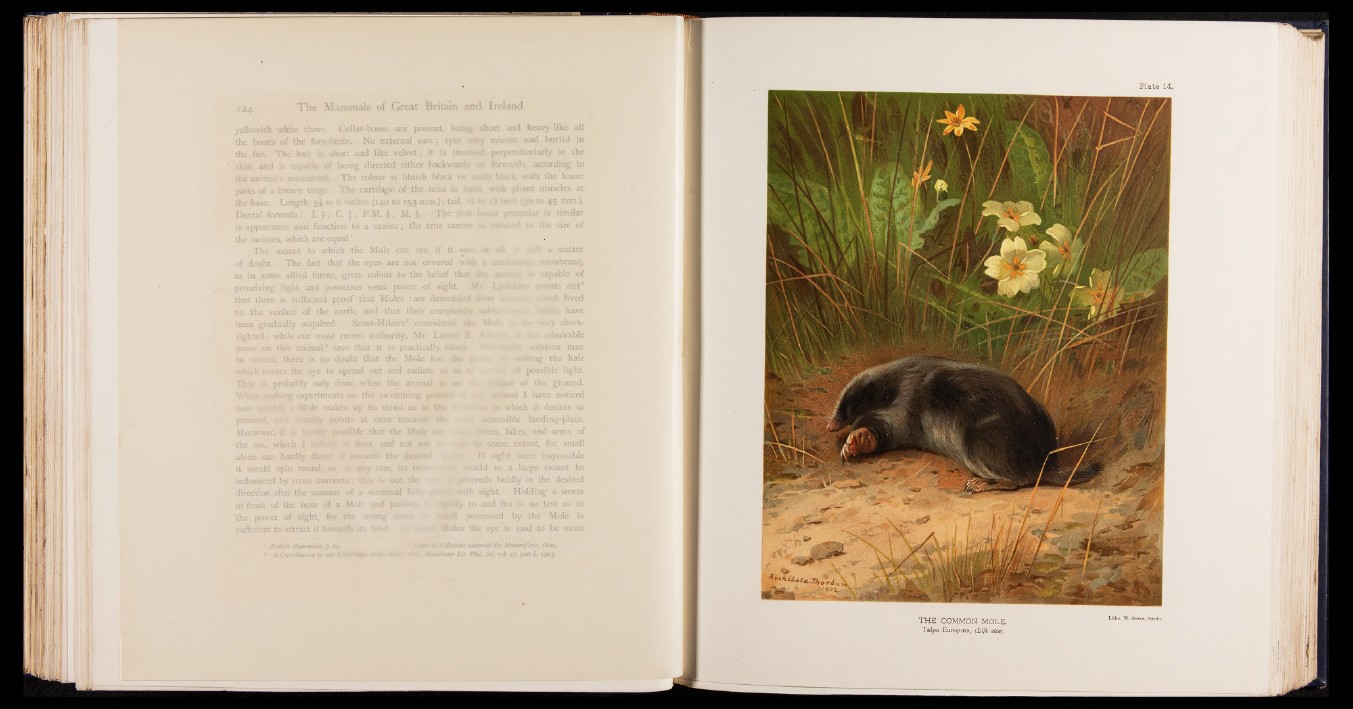
yellowish white claws. Collar-bones are present, beia
the bones of the fore-limbs. No external ears; eyes
the .far.. The. hair is short and like velvet; it is i-nse
skin, and is capable of being directed either backwards
the animal's movement The colour is bluish black or
parts of a brown tinge. The cartilage of the nose is h
the base. Length, 5i to 6 inches (140 to 153 mm.); tail, )
t)ental formula: 1. 1-; C. | ; P.M. •£; M. 4- ‘ The firs
in appearance and function to a canine; the true canin
short and heavy like all
f minute and buried in
i perpendicularly in the
r forwards, according to
jtv black, with the lower
, with pliant muscles at
a i f inch (30 to 45 mm.).
f#&e presnoiar is similar
s redticwi to the size of
the incisors, which are equal.’
> at all v* a matter
h it membrane,
the a*-..- is capable of
Mr. LvEE-.k'-’ points out1
The extent to which the Mole can see, if it see;
of doubt. The fact that the eyes are not covered wit!
as in some allied forms, gives colour to the belief that
perceiving light and possesses some power of sight. .
that there is sufficient proof that Moles ‘ are descended
On the surface of the earth, and that their completely
been gradually acquired.’ Saint-Hilaire* considered
sighted; while our most recent authority, Mr. Lionet E.
paper on this animal,’ says that it is practically hts&d.
be correct, there is no doubt that the Mole has the j.
which covers the eye to spread out and radiate so as r
This is probably only done when the animal hi an
WEeo experiments on the swimming powers
■ jv.-.,y: a Mole makes up its mind as to the
proceed, points at once towards the
Moreover, it b. p^stble that the Mole u
the sea, which, i A does, and not use t?
alone can hardly direct A .towards the desired
it would spin round, or. at any rate, its mov.
influenced by cross currents; this is not the
direction after the manner of a mammal fui
in front of the nose of a Mole and passim,
■ .ich lived
■ subt:.; ' . - i i - i r p h a v e
very short-
m i;e .admirable
solution may
v;-.iking the hair
,ii! possible light.
irv{is:c of the ground.
>nmal I have noticed
m m which it desires to
b accessible landing-place,
r ivcrs,. lakes, and arms of
fo some extent, for smell
ff sight were impossible
mid to a large extent be
:eeds boldly in the desired
i sight. Holding a worm
0 and fro is no test as to
the power of sight, for the strong sesesf ■ *meil possessed by the Mole is
sufficient to attract it towards its food &g|g| Moles the eye is said to be more
1Histoire naturelle des hfammifhres, 1829.
ester lit . P h il Soc. voL 47, part ii. 1903.
THE COMMON MOLE.
Talpa Europoea, (Life size).